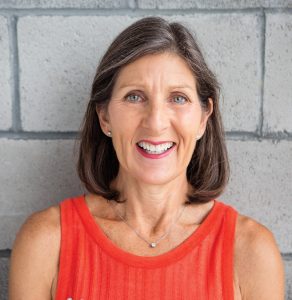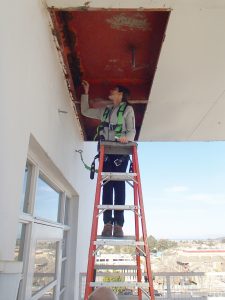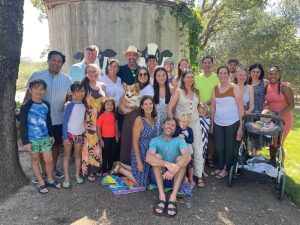Maryann Phipps has worked as a structural engineer for 40 years, evaluating, designing, and renovating buildings in California. She is an active leader in the engineering community and a regular speaker on earthquake performance and the seismic protection of non-structural building components. In 2022, she was inducted into the National Academy of Engineering. She received the H.J. Brunnier Lifetime Achievement Award from the Structural Engineers Association of Northern California in 2020, serving as the organization’s first female President in 1993.

She founded Estructure in 2000 to provide specialized and client-focused structural engineering services for public and private clients wishing to address earthquake hazard risks. Her firm specializes in complex building projects focusing on health care and laboratory renovations, seismic evaluations and retrofits, interior renovations, and infrastructure improvements.
After many years in the industry, you decided to start your own company. What compelled you to do this? What lessons did you learn that our readers would benefit from?
I never intended to start a firm! I was happily working at Degenkolb Engineers and was a Senior Principal there. However, after 18+ years, I left for a few reasons: 1) I did not have enough time to spend with my two children, 2) I am a “hands-on” engineer who loves getting dirty on job sites, working directly with clients, and knowing every aspect of a project which can be hard to do in a large firm; and 3) I wanted to have more than one professional experience in my life. So, when I left, I started working solo out of my house. Growing a firm started organically several years later.
The lesson, from my perspective, is to check in with yourself and ask if what you are doing feels right. Of course, there are up and down cycles in all professional lives, but if we look inward and listen to our hearts, we can probably judge if we are living our best lives. If something doesn’t feel right, it’s probably time to make a change – either by altering how you are doing your job, where you are doing it or, in some cases, what you are doing.
Your firm is small. Did you ever consider growing it into something larger?
Bigger is not necessarily better; it is just different. We are very intentionally the size we are. It enables everyone to participate actively in the firm and for all voices to be heard. We can be nimble, and we each know what is going on in the office, so anyone can step in if there is a need. The bottom line is that the size enables us to share a close bond and feel a deep sense of community. That feels right for us.
Are you missing out on larger projects, the ones that younger staff want to do and are attractive to applicants when recruiting?
You are right that there are tradeoffs. We make sure that every new engineer has the opportunity to work on a “pure” structural design project from beginning to end. I think that is critically important for learning. The upside is that, because of the scale, they work on virtually all aspects of the project rather than a piece of a large project. There is nothing like the satisfaction of seeing your design built (and nothing quite as informative as learning from your mistakes!). We also do some larger multi-phased projects that last several years. The number and variety of projects have proven to be engaging, satisfying, and a great foundation for learning.
We want to congratulate you on being elected to the National Academy of Engineering. Would you share some things that helped you attain this recognition?
Thank you. I am honored to have been inducted. Election to the Academy starts with members compiling a detailed nomination (without the candidate’s knowledge), followed by a multi-layer rigorous review process. I believe my nomination to the Academy is partly related to my role in the profession. First, I entered when there were very few women in structural engineering and thus was the first woman in many leadership positions. That visibility helped foster growth in the next generation of women engineers. The second reason is related to my work on the seismic protection of non-structural components. This has become an area of specialization and a passion of mine, which has helped draw attention to this important subject.
Many engineers don’t pay much attention to non-structural components, leaving it to others. Why, in your view, is this a mistake?
In the U.S., most earthquake losses result from non-structural damage. Measures can be taken to reduce those losses, and I believe that structural engineers are in the best position to guide the design of protective measures. From my perspective, it is not essential that the Structural Engineer of Record design the seismic anchorage/bracing for every component on a project. Rather, I believe the SEOR should, at minimum, work with owners to establish acceptable non-structural performance objectives, prepare performance specifications for the design and construction of non-structural protective measures, and confirm that the work is completed as intended.
What was it like entering the profession when there were very few women in the industry?
I can say with profound gratitude that I was treated fairly throughout my career. I felt welcomed into the profession with open arms, and my upward climb was merit-based. I was judged by performance and never felt held back. Jobsites were, of course, very different back then. I had to overlook the pin-ups in the job site trailers, and there were a few minor uncomfortable moments. But these are incidental to my overall experience. I recognize that not everyone is as fortunate to work in an environment where you are accepted for what you bring to the team, without regard to any other factor.
Of all the projects you have worked on, would you describe the one or two that are the most memorable and why?
After 42 years, there are many projects to consider! One of the earliest comes to mind. My first large project was a four-story vertical addition to a Sutter Stockton parking garage near Union Square in San Francisco. It was incredibly memorable and formative because I was on site daily during construction and I learned so much seeing my design turned into reality. Most importantly, I saw firsthand what did not work or could have worked better and learned directly from the contractors responsible for implementation. This experience transformed how I design and detail (always with consideration of constructability). Also, our firm was the Prime Design Professional on the project, which meant that I was directly responsible for helping to manage and coordinate the work of all other disciplines (architectural, mechanical, electrical, plumbing, and fire protection). This collaboration among AMEP consultants and the construction team has become a cornerstone of my professional career and the part I enjoy the most.
Successful firms plan for ownership transition and firm longevity. Without giving away any secrets, what is your philosophy on the subject?
I’m glad you asked. I am very happy to share my thoughts on this. I have spent much time figuring out how to do this well. Consistent with my personal beliefs and the values of my firm, we set up an Employee Stock Ownership Plan (ESOP) as the vehicle by which the firm will be effectively given to the Estructure staff. I wanted to transition in a way that acknowledges the role everyone has played in our success, does not impose a financial burden on the staff, and enables the team to continue to benefit from their hard work.
Regarding mentoring, what is your approach, and what have you found that works best?
Mentoring takes many forms. At Estructure, mentoring happens primarily through working together on projects one-on-one. I always try to provide big picture perspective and context to any task. I also share all facets of the business. We have an open book policy where all our firm’s financial information is shared except for compensation packages. This helps everyone understand the business and enables us to work more effectively toward achieving collective goals. Job site visits are important mentoring opportunities and invaluable learning experiences for young engineers. The time driving to and from a job site can be equally valuable as relationships are strengthened and grown.
You have demonstrated a long and dedicated commitment to professional activities. What is the most rewarding aspect of your service, and was it worth it and why?
You are right; I’ve invested a lot of time in professional activities. It helped me grow and learn. My leadership skills were jumpstarted by chairing committees in SEAONC, and participation in technical research projects broadened and deepened my understanding of structures and earthquake engineering. But by far, most importantly, it connected me to so many other amazing professionals. One of the things I love about our profession is the comradery and mutual support. I feel like I can reach out to almost any other structural engineer with a question, and I will receive an answer without reservation. I am so proud to be part of this profession.
Work-life balance has been a hot topic for several years. Recently doing just enough to get by seems to be a trend too. What advice would you give to young engineers?
I am acutely aware of the trend and have mixed feelings about it. On the one hand, you get out what you put in. Personally, I can attribute much of my success to the professional investments I made well outside of a 9-to-5 workday. I also believe that the satisfaction I derive from work has helped me be a better parent, friend, and citizen. On the other hand, I think it is essential to live a rich, full life outside of work and believe that the purpose of work is, in part, to help us live our best lives. I don’t think they are two mutually exclusive options. Rather, I believe the work-life balance is dynamic and can adjust to accommodate our opportunities, desires, and needs.
What do you think you will be remembered for in terms of your personal legacy, and/or what are you most proud of?
Hmmm, this is a hard one. For those close enough to know, I think I will be remembered for approaching business differently. To me, it is all personal. I care deeply about my staff and my clients. I have clarity on my priorities and have used them to guide our business: 1) take care of each other, 2) take care of our clients, and 3) make enough money. This set of priorities serves as the north star from which all business decisions are made. I’m certain you do not have to give up being people-focused in favor of financial success. I am very proud of running a small, successful, team-focused structural engineering firm.
We all have mentors and people who helped us be successful. So, in closing, who would you like to thank and why?
I can still hear the voices of Tom Wosser and David Bonneville (both from Degenkolb San Francisco) from decades ago. They taught me so much – my approach to problem-solving, understanding of structures, and technical writing skills come from them. My joy in the profession comes from all the wonderful engineers I have worked with and with whom I have become friends. And honestly, the team I work with at Estructure is my community and essential to my well-being. I am so grateful to work with the people I do.■


